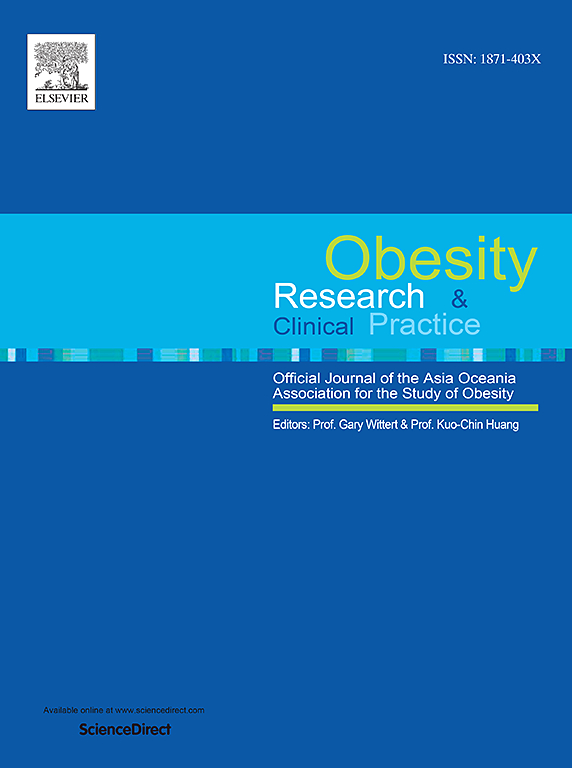The recruitment of adolescents with obesity to a randomised controlled trial: A Fast Track to Health sub-study
IF 2.5
4区 医学
Q3 ENDOCRINOLOGY & METABOLISM
引用次数: 0
Abstract
Aims
Behavioural weight management interventions facilitate short to medium-term weight and cardiometabolic improvements in adolescent obesity. However, recruiting adolescents to trials of such interventions is challenging. This study describes strategies used to recruit adolescents with obesity into the Fast Track to Health (Fast Track) trial, conducted at two tertiary paediatric centres in Australia.
Methods
Fast Track (HREC/17/SCHN/164) was a randomised controlled trial that recruited 13–17-year-olds with obesity and ≥ 1 cardiometabolic complication, from December 2017 to March 2022. Families underwent phone screening, followed by in-person screening appointments. Recruitment strategies were grouped and enrolment yield by strategy was calculated.
Results
Of 308 inquiries received, 141 (45.8 %) adolescents were recruited. The most successful strategy was referral from specialists at participating centres (21.2 % enrolment yield), followed by referrals from family/friends (6.5 %), other doctors/general practitioners (3.6 %), and social media (3.6 %). Social media was used for 11 months only (enrolment yield - 8.5 %). Recruitment strategies with low yield were study flyers/posters (1.6 %), digital/print media (1.3 %), and the study website (1.0 %). Of 137 adolescents excluded at phone screening, most were due to disinterest in participation or inability to make contact (60.6 %). Of 171 adolescents attending in-person screening, 30 did not meet inclusion criteria (n = 7 of those excluded had no metabolic complications, n = 7 were outside the BMI range).
Conclusion
Connecting with medical specialists may be important to support the engagement of treatment-seeking adolescents with obesity in clinical trials. Further research is needed to identify methods of enhancing clinical trial recruitment in primary care, community settings, and online.
招募肥胖青少年参加随机对照试验:健康快速通道亚研究
目的:行为体重管理干预促进青少年肥胖的中短期体重和心脏代谢改善。然而,招募青少年参加此类干预措施的试验是具有挑战性的。这项研究描述了在澳大利亚的两个三级儿科中心进行的招募肥胖青少年进入健康快速通道(Fast Track)试验的策略。方法:快速通道(HREC/17/SCHN/164)是一项随机对照试验,招募13-17岁肥胖且≥ 1心脏代谢并发症的青少年,时间为2017年12月至2022年3月。家庭先进行电话筛查,然后再进行面谈预约。对招生策略进行分组,计算各策略的招生率。结果:308份问卷中,141名青少年(45.8 %)被招募。最成功的策略是来自参与中心的专家推荐(21.2 %入学率),其次是来自家人/朋友(6.5% %)、其他医生/全科医生(3.6% %)和社交媒体(3.6% %)的推荐。社交媒体仅使用了11个月(注册率- 8.5 %)。低收益的招募策略为研究传单/海报(1.6 %)、数字/印刷媒体(1.3 %)和研究网站(1.0 %)。137名青少年被排除在电话筛查之外,大多数是因为对参与不感兴趣或无法联系(60.6% %)。在171名参加现场筛查的青少年中,有30名不符合纳入标准(n = 被排除的人中有7人没有代谢并发症,n = 7人不在BMI范围内)。结论:与医学专家联系对于支持在临床试验中寻求治疗的肥胖青少年的参与可能是重要的。需要进一步的研究来确定在初级保健、社区环境和网上加强临床试验招募的方法。
本文章由计算机程序翻译,如有差异,请以英文原文为准。
求助全文
约1分钟内获得全文
求助全文
来源期刊

Obesity research & clinical practice
医学-内分泌学与代谢
CiteScore
7.10
自引率
0.00%
发文量
80
审稿时长
49 days
期刊介绍:
The aim of Obesity Research & Clinical Practice (ORCP) is to publish high quality clinical and basic research relating to the epidemiology, mechanism, complications and treatment of obesity and the complication of obesity. Studies relating to the Asia Oceania region are particularly welcome, given the increasing burden of obesity in Asia Pacific, compounded by specific regional population-based and genetic issues, and the devastating personal and economic consequences. The journal aims to expose health care practitioners, clinical researchers, basic scientists, epidemiologists, and public health officials in the region to all areas of obesity research and practice. In addition to original research the ORCP publishes reviews, patient reports, short communications, and letters to the editor (including comments on published papers). The proceedings and abstracts of the Annual Meeting of the Asia Oceania Association for the Study of Obesity is published as a supplement each year.
 求助内容:
求助内容: 应助结果提醒方式:
应助结果提醒方式:


